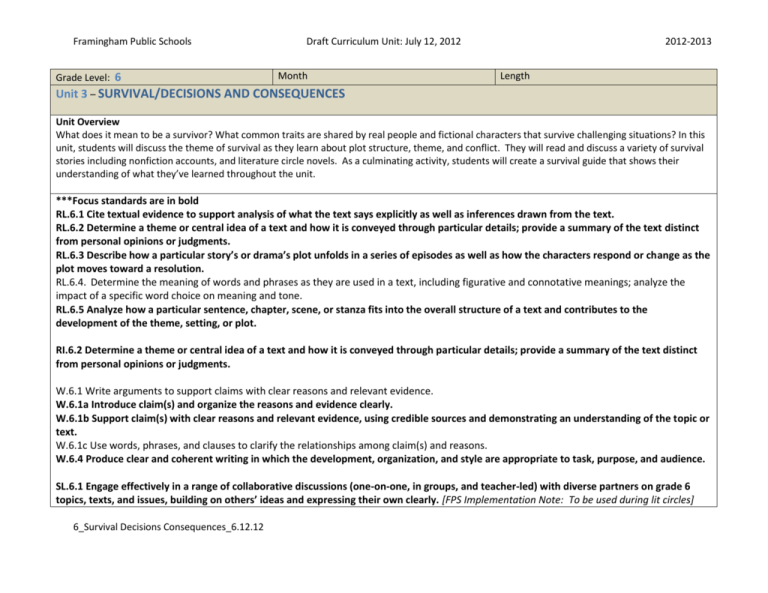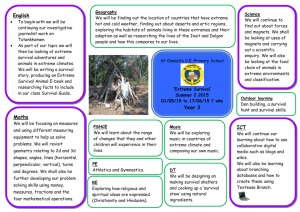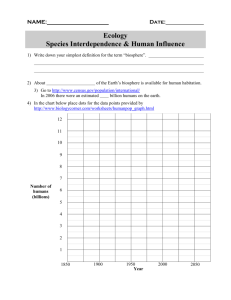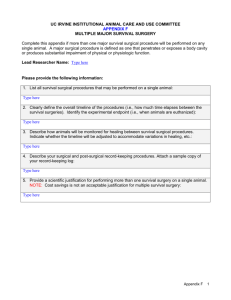Survival, Decisions, Consequences Unit
advertisement

Framingham Public Schools Grade Level: 6 Draft Curriculum Unit: July 12, 2012 Month 2012-2013 Length Unit 3 – SURVIVAL/DECISIONS AND CONSEQUENCES Unit Overview What does it mean to be a survivor? What common traits are shared by real people and fictional characters that survive challenging situations? In this unit, students will discuss the theme of survival as they learn about plot structure, theme, and conflict. They will read and discuss a variety of survival stories including nonfiction accounts, and literature circle novels. As a culminating activity, students will create a survival guide that shows their understanding of what they’ve learned throughout the unit. ***Focus standards are in bold RL.6.1 Cite textual evidence to support analysis of what the text says explicitly as well as inferences drawn from the text. RL.6.2 Determine a theme or central idea of a text and how it is conveyed through particular details; provide a summary of the text distinct from personal opinions or judgments. RL.6.3 Describe how a particular story’s or drama’s plot unfolds in a series of episodes as well as how the characters respond or change as the plot moves toward a resolution. RL.6.4. Determine the meaning of words and phrases as they are used in a text, including figurative and connotative meanings; analyze the impact of a specific word choice on meaning and tone. RL.6.5 Analyze how a particular sentence, chapter, scene, or stanza fits into the overall structure of a text and contributes to the development of the theme, setting, or plot. RI.6.2 Determine a theme or central idea of a text and how it is conveyed through particular details; provide a summary of the text distinct from personal opinions or judgments. W.6.1 Write arguments to support claims with clear reasons and relevant evidence. W.6.1a Introduce claim(s) and organize the reasons and evidence clearly. W.6.1b Support claim(s) with clear reasons and relevant evidence, using credible sources and demonstrating an understanding of the topic or text. W.6.1c Use words, phrases, and clauses to clarify the relationships among claim(s) and reasons. W.6.4 Produce clear and coherent writing in which the development, organization, and style are appropriate to task, purpose, and audience. SL.6.1 Engage effectively in a range of collaborative discussions (one-on-one, in groups, and teacher-led) with diverse partners on grade 6 topics, texts, and issues, building on others’ ideas and expressing their own clearly. [FPS Implementation Note: To be used during lit circles] 6_Survival Decisions Consequences_6.12.12 Framingham Public Schools Draft Curriculum Unit: July 12, 2012 2012-2013 SL.6.1a Come to discussions prepared, having read or studied required material; explicitly draw on that preparation by referring to evidence on the topic, text, or issue to probe and reflect on ideas under discussion. SL.6.1b Follow rules for collegial discussions, set specific goals and deadlines, and define individual roles as needed. SL.6.1c Pose and respond to specific questions with elaboration and detail by making comments that contribute to the topic, text, or issue under discussion. SL.6.1d Review the key ideas expressed and demonstrate understanding of multiple perspectives through reflection and paraphrasing. SL.6.2 Interpret information presented in diverse media and formats (e.g., visually, quantitatively, orally) and explain how it contributes to a topic, text, or issue under study. L.6.1 Demonstrate command of the conventions of standard English grammar and usage when writing or speaking L.6.2 Demonstrate command of the conventions of standard English capitalization, punctuation, and spelling when writing L.6.3 Use knowledge of language and its conventions when writing, speaking, reading, or listening. L.6.5 Demonstrate understanding of figurative language, word relationships, and nuances in word meanings. Overarching Standards: RL.6.10 By the end of the year, read and comprehend literature, including stories, dramas, and poems, in the grades 6–8 text complexity band proficiently, with scaffolding as needed at the high end of the range. RI.6.10 By the end of the year, read and comprehend literary nonfiction in the grades 6–8 text complexity band proficiently, with scaffolding as needed at the high end of the range. W.6.10 Write routinely over extended time frames (time for research, reflection, and revision) and shorter time frames (a single sitting or a day or two) for a range of discipline-specific tasks, purposes, and audiences. SL.6.6 Adapt speech to a variety of contexts and tasks, demonstrating command of formal English when indicated or appropriate. (See grade 6 Language standards 1 and 3 on page 65 for specific expectations.). L.6.6 Acquire and use accurately grade-appropriate general academic and domain-specific words and phrases; gather vocabulary knowledge when considering a word or phrase important to comprehension or expression. Key Understandings to Explore 1. There are different types of survival (physical, emotional, personal, species) 2. Survivors (real and fictional characters) share common traits that help them overcome adverse situations 3. Survival is a common theme in fiction and nonfiction. 6_Survival Decisions Consequences_6.12.12 Framingham Public Schools Draft Curriculum Unit: July 12, 2012 2012-2013 Essential Questions for thought, discussion, and collaboration 1. In the face of adversity why do some people survive while others don’t? 2. What does it take to be a survivor? Declarative and Factual Knowledge (Recall, memorize, define) Students will know… 1. The common qualities survivors possess 2. Characters’ response to conflict influences outcomes 3. A story’s details can be used to determine theme 4. A summary is a brief statement or restatement of the main points of a story or text and does not include personal opinion or commentary. 5. Literary terms and vocabulary appropriate to the unit being studied. Skills (Organize, apply, analyze, integrate, evaluate) Students will be able to…. 1. Determine a theme and explain how it’s conveyed through detail 2. Explain how characters change and respond to change as the plot moves toward resolution. 3. Analyze how a particular sentence or scene fits into the overall structure of a text and contributes to the development of the theme. 4. Summarize a text without including personal opinions of judgments 5. Support claims with evidence from text. 6. Create a survival guide that is clear, coherent, organized and appropriate to the task. Key Vocabulary: summary, theme, adversity, conflict (internal and external), consequences, perseverance, determination, tenacity, motivation, willpower, evidence, intuition Performance Assessments Students will write a summary (addressing pivotal events and the conflict) on literature circle book. Students will create a survival guide (summative) 6_Survival Decisions Consequences_6.12.12 Other Evidence/Assessments Vocabulary Students will write a summary of “Hating Hansen” from Rogue Wave by Theodore Taylor Conflict letter writing activity Framingham Public Schools Draft Curriculum Unit: July 12, 2012 Unit Title (continued from previous page): Literary Texts: Stories/Novels Short Stories Tuesday of the Other June by Norma Fox Mazer (McDougal Littell Anthology the Language of Literature) “Hating Hansen” from Rogue Wave by Theodore Taylor Literature Circles: Downriver by Will Hobbs Touching Spirit Bear by Ben Mikaelsen Among the Hidden, Fever 1793 by Laurie Halse Anderson Stone Fox, by John Reynolds Gardiner Julie of the Wolves, by Jean Craighead George Stranded by Ben Mikaelsen Hatchet by Gary Paulsen The River by Gary Paulsen Far North by Will Hobbs Black Star, Bright Dawn by Scott O’Dell Antarctica by Peter Lerangis Peak by Roland Smith My Side of the Mountain Everest by Gordon Korman – three books in the series (for struggling learners) Picture Books for survival theme: The Cello of Mr. O by Jane Cutler Riding the Tiger by Sweet Clara Informational Texts Blizzard by Jim Murphy “Choosing to Live” from People: Amazing Stories of Survival (see literacy specialist for a copy of this book) “Hanging Tough” from People: Amazing Stories of Survival “His Partner Cut the Rope” from People: Amazing Stories of Survival 6_Survival Decisions Consequences_6.12.12 2012-2013 Framingham Public Schools Draft Curriculum Unit: July 12, 2012 2012-2013 Art/Music/Media http://www.youtube.com/watch?v=Y9AimKPmaKg (Aron Ralston on David Letterman, youtube) http://video.nytimes.com/video/2009/03/31/sports/othersports/1194838580097/being-aron-ralston.html (Aron Ralston Interview) http://www.youtube.com/watch?v=duelon0MF2o (Bethany Hamilton tells her story) PowerPoint presentation on conflict Online Resources Nationalgeographic.com/adventure/your-story/survival-stories (real life case studies of survival) Scope Magazine: Surviving the Tsunami, Jan. 30, 2012 (http://teacher.scholastic.com/scholasticnews/magazines/scope/pdfs/SCOPE-013012Tsunami.pdf) Differentiation for Struggling Learners and ELL Interdisciplinary Connections 6_Survival Decisions Consequences_6.12.12 Framingham Public Schools Draft Curriculum Unit: July 12, 2012 2012-2013 Lesson Title: Survival Theme (Two days) Lesson Summary: Introduction to the Unit theme (Survival) Learning Objectives: Generate common characteristics of survivors, activate students’ background knowledge about survival . Materials: Suggested Questions/Ideas to Activate Students’ Knowledge About Survival MimioVote (see tech. specialist for updated Mimio software) or hard copy of Anticipation Guide Unit vocabulary/Word Sort Video clips: http://video.nytimes.com/video/2009/03/31/sports/othersports/1194838580097/being-aron-ralston.html (Aron Ralston Interview) http://www.youtube.com/watch?v=Y9AimKPmaKg (David Letterman Interview of Aron Ralston) http://www.youtube.com/watch?v=duelon0MF2o (Bethany Hamilton tells her story) Lesson Title: Elements of Short Story (Three days) Lesson Summary: Review elements of a short story. Read Tuesday of the Other June. Complete plot diagram and character inference chart. Learning Objectives: Revisit elements of a story, complete a plot diagram, identify evidence to support claims about a character Materials: Tuesday of the Other June Plot Diagram Character Inference Chart Lesson Title: Literature Circles (Begins in the first week, continue 1-2 days per week for the remainder of the unit) Lesson Summary: Introduce literature circles with book talks, introduce and model literature circle roles and behaviors using Tuesday of the Other June, meet in literature circle, complete a variety of learning activities on literature circle book. Review and discuss key vocabulary throughout unit. Learning Objectives: Collaboratively discuss literature circle book in a small group, cite evidence from text, determine how a plot unfolds and how characters change and respond to change. Materials: Literature circle books Literature circle roles/behaviors Handouts describing roles Handouts describing behaviors Copy of Tuesday of the Other June 6_Survival Decisions Consequences_6.12.12 Framingham Public Schools Draft Curriculum Unit: July 12, 2012 2012-2013 Handout with student role for that week Calendar Character inference sheet Reflection sheet Hotseat activity Found poem activity Clues to theme informational sheet Theme organizer worksheet Lesson Title: Conflict (1 day, introduction, not an assessed standard) Lesson Summary: Students will view a Power Point presentation on types of conflict and discuss how characters change as a result of conflict and how Characters respond to conflict. Learning Objectives: Students are introduced to types of conflict. Students learn about different types of conflict and how they influence a story. Materials: PowerPoint presentation on conflict. Lesson Title: Summary (3 days and a final performance assessment) Lesson Summary: Teacher models step by step summarizing using the Aron Ralston article “Choosing to Live”. Students read a non-fiction article in heterogeneous groups using “Hanging Tough”, complete a graphic organizer and write a group summary. For homework students will write an individual summary based upon a leveled articled. Learning Objectives: Students will learn that a summary is a brief statement or restatement of the main points of a story or text and does not include personal opinion or commentary. Students will summarize an article without including personal opinions of judgments. Materials: Article about Aron Ralston “Choosing to Live” from People: Amazing Stories of Survival Step-by-step Summarizing instructions and graphic organizer Instructional article: Hanging Tough from People: Amazing Stories of Survival Leveled HW Articles: excerpt from Blizzard (last paragraph pg. 19 through pg. 24.) (high), His Partner Cut the Rope (medium) from People: Amazing Stories of Survival 6_Survival Decisions Consequences_6.12.12 Framingham Public Schools Draft Curriculum Unit: July 12, 2012 2012-2013 Lesson Title: Elements of a Story (2 days) Lesson Summary: Students will silently read “Hating Hansen” from Rogue Wave by Theodore Taylor — first independently and then following along with the text as the teacher and/or skillful students read aloud. Depending on the difficulties of a given text and the teacher’s knowledge of the fluency abilities of students, the order of the student silent read and the teacher reading aloud with students following might be reversed. Complete a plot diagram. Discuss how the character changes. Fold in RL.6.5. Use this as an opportunity to revisit summary, having students write summaries individually using the plot diagram and summary graphic organizer. Ask students to peer edit one another’s writing. Lesson Objectives: Analyze how particular parts of a story fit into the overall structure of a text and contributes to development of the survival theme. Materials: “Hating Hansen” from Rogue Wave by Theodore Taylor Plot diagram Summary graphic organizer Lesson Title: Citing evidence that relates to conflict and theme through a close read (3 days) Lesson Summary: Model a close read using a picture book (Riding the Tiger or The Cello of Mister O) to cite evidence from the text that relates to conflict and the theme of survival. Practice answering guided questions that require students to cite evidence from the text. Students will then reread a specific passage taken from “Hating Hansen” in response to a set of concise, text-dependent questions that compel them to examine the meaning and structure of the text. Lesson Objectives: Students will cite evidence from text to support analysis of text. Materials: Riding the Tiger or The Cello of Mister O Close reading template, including the passage from “Hating Hansen”. Lesson Title: Final assessments Lesson Summary: Vocabulary assessment, summary assessment and create a survival pamphlet. Lesson Objectives: Materials: Vocabulary assessment Survival guide directions (teacher created) Rubric for survival guide that includes L.6.2 (teacher created) 6_Survival Decisions Consequences_6.12.12 Framingham Public Schools 6_Survival Decisions Consequences_6.12.12 Draft Curriculum Unit: July 12, 2012 2012-2013









